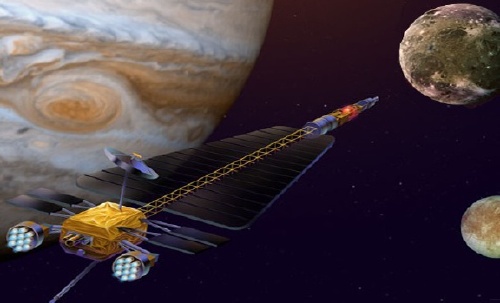 |
|||||
|---|---|---|---|---|---|
| EXPLORING THE JUPITER SYSTEM | |||||
| Jupiter | Moons | Oceans | Volcanos | Rings | Radio |
| JIMO | Galileo | Cassini | Pioneer | Voyager | Resources |
Is There Ocean Life on Jupiter's Moons?
CALLISTO » EUROPA » MOONS OF THE SOLAR SYSTEM »
Are Warm Slush Oceans Buried on Europa?
Could There be Life In buried oceans of warm slush on the moon Europa? Researchers have concentrated a lot of effort on Jupiter's intriguing moon Europa. The images from Galileo suggest that Europa's icy surface hides a layer of warm slush or even liquid water. That might make it the only place in the Solar System, other than Earth, known to have that sort of life-sustaining liquid.
Could one or more of the moons of Jupiter be hospitable to life? Could life have blossomed on one of those moons? Some astrobiologists say that a combination of physical conditions on the moon Europa could nurture life in the subsurface ocean, which couldoffer heat as well as water.
Europa is an icy world that seems to be pock marked with streaks of color as if it were contorted continuously by the powerful pull of its planet. Such tidal forces probably could warm a subsurface ocean, sometimes pushing pockets of liquid to the surface. That action might nudge primitive life forms to evolve to higher forms.
Europa has the largest salty ocean in our Solar System, according to scientific interpretations of Galileo's photos and science measurements. If it's there, that ocean lies underneath the moon's frozen surface.
In addition to water, life would benefit from heat. The gravitational tides forced on the moon by Jupiter could generate heat. Tidal forces periodically stretch the moon's icy surface as more than 1,600 ft. above normal sea level. Friction from the tidal pull sometimes might generate enough heat to melt ice on the moon's surface. Surface photos snapped by Galileo show what looks like cracks when the frozen surface frequently thaws and refreezes.
There may be a place for life to exist -- a biosphere -- from far below the surface to just above the surface crust. That could be a balanced environment with the stability and variety to encourage life to flourish and adapt. Organisms might mimic microbial life forms in Earth's oceans, using photosynthesis for nourishment.
Of course, not all scientists agree. Others suggest the prospects of finding something alive on Europa are extremely slim.
Europa's ice crust is two miles deep. Impact craters on the moon show that its brittle ice shell crust is more than 1.8 to 2.4 miles thick.
Galileo swooped by the intriguing moon numerous times during the years it was at work in the Jovian System. For instance, one close encounter came in December 1997 when the spacecraft flew 124 miles above Europa's surface.
Galileo images of Europa showed features that support the notion of a buried ocean. Structures that now look like giant blisters may have been formed as warm material welled up inside Europa, like giant blobs within a lava lamp. Natural heat inside Europa, from radioactive minerals and from the friction of being tugged around by Jupiter's gravitational pull, might keep Europa warm enough for its interior to be molten.
Some of Galileo's pictures made it seem the lava-lamp blobs might have lifted minerals up toward the moon's surface. Instruments aboard Galileo found areas where magnesium and sulfate-rich salts are concentrated. Such evidence suggests that Europa was once partly liquid, but the timing of those ancient events is unknown. Researchers want to know if Europa's core has been warm throughout geological history.
Some astronomers suggest Europa has been active geologically during the recent several million years. Others claim it has been quiet for at least 3 billion years.
Is There An Ocean Inside Callisto?
Jupiter's large moon Callisto is the outermost of the four large jovian natural satellites. The other three are Io, Europa and Ganymede.
Callisto appears to have been rocked in ancient times when some large object -- possibly an asteroid or comet -- crashed into an area known today as the Valhalla Basin.
In fact, Callisto is the most heavily cratered body in the Solar System and it may have a vast water ocean indside.
The Galileo probe, which travelled around Jupiter's system of moons from 1995, sent back to Earth new close-up pictures of the side of Callisto directly opposite the Valhalla Basin. Interestingly, the back side of the moon shows no effect from the impact on the other side at Valhalla Basin, according to NASA's Jet Propulsion Laboratory. That probably means that an underground ocean cushioned the blow of the impact.
Other bodies of our Solar System, such as the planet Mercury and Earth's Moon, have similar impact basins. However, unlike Callisto, they have grooved hilly terrain on the back side attributed to intense seismic shocks from collisions with large objects. Unlike Callisto, they did not have underground reservoirs to soften a blow.
Galileo snapped the Callisto photographs opposite Valhalla Basin in May 2001 as it flew within 20,000 miles of the icy, rocky moon. Callisto, with a surface of ice and rock, is the most heavily cratered of any moon in our Solar System.
The new discovery echoes a theory put forth in the 1990s by astronomers who suggested that a liquid layer inside Callisto could cushion collisions on the exterior.
Callisto was discovered along with Io, Europa and Ganymede in 1610 as astronomer Galileo Galilei was skygazing from his garden in Padua, Italy. He was surprised to see four small "stars" near Jupiter. They turned out to be Jupiter's four largest moons known collectively today as the Galilean satellites.
Solar System Search STO STO cover Questions Feedback Suggestions © 2004 Space Today Online